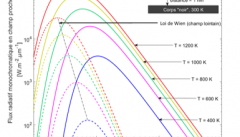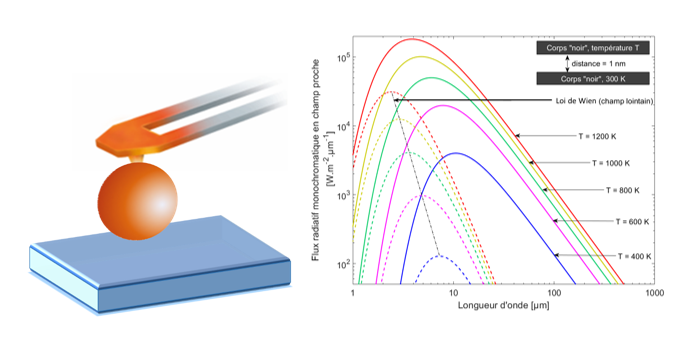
Research activities
Stefan-Boltzmann's law is not valid at nanoscale
Thermal radiation is described in particular by the celebrated Stefan-Boltzmann law, established in 1884. It makes it possible to deduce that the radiative flux emitted by an ideal body, called ‘black’, is proportional to the fourth power of temperature. Researchers have shown that this law is modified when the heat-exchanging surfaces are close, for nanometric distances: the exponent, which depends on the materials, is reduced compared to large distances.
Thermal radiation is one of the three modes of heat transfer, where energy is carried by light. The feeling of warmth on a beautiful day when you stand facing the sun, a body of very high temperature and very far away, is a manifestation of thermal radiation. This highlights two key features: thermal radiation is associated with hot bodies and can propagate over very long distances. Thermal radiation is notably described by the famous Stefan-Boltzmann law, established in 1884 by Jozef Stefan (1835-1893) and his doctoral student Ludwig Boltzmann (1844-1906). It makes it possible to deduce that the radiative flux emitted by an ideal body, called "black", is proportional to the fourth power of temperature. For real (non-ideal) bodies, this law is no longer exact and the constant of proportionality changes, but the very strong temperature dependence, which associates thermal radiation with hot bodies, persists.
Several characteristics of thermal radiation have, however, been called into question since the end of the 20th century, with the advent of nanotechnology. Distances between bodies are now nanometric in many cases, which is much smaller than the characteristic size of carriers of thermal radiation - photons -, which is on the order of 10 micrometers (10,000 nanometers) at room temperature. For these distances, thermal radiation takes place by a photon tunneling mechanism, called ‘near-field radiation’, and becomes much more dependent on distance than in the ‘far-field’ regime described by the Stefan-Boltzmann law. Numerous experimental confirmations of the very large increase of the radiative flux exchanged in this regime have been observed during the last decade, and applications for the conversion of thermal energy into electricity or for spectroscopy are under development [1].
However, the dependency of radiative transfer on temperature had not been analyzed in detail for short distances. A group of CNRS researchers at the Centre for Energy and Thermal Sciences of Lyon (CETHIL, located at the National Institute for Applied Science – INSA - in Lyon) and at the Institute for Electronics and Systems (IES) in Montpellier therefore decided to check if the radiative flux in the ‘near field’ regime is still exhibiting the fourth power dependence on temperature. Their work shows that, for a ‘black’ body that does not reflect but absorbs radiation, a proportionality to the square of the temperature is expected at very short distances, which is less strong than that of Stefan-Boltzmann's law. Experimental studies have been carried out with several real bodies, using thermal atomic force microscopy (called scanning thermal microscopy, SThM), which allows to control the distance between the bodies but also their temperatures. The results clearly confirm that the temperature dependence is attenuated in the near field. However, there may be variations depending on the type of material considered.
This work, published in Materials Today Physics [2], complements recent studies showing that the temperature dependence of thermal radiation, in the far field this time, can also vary when the size of bodies becomes nanometric [3]. They also show that it will be easier to intensify radiative transfer by bringing bodies closer than by increasing temperature, which should be taken into account in the design of applications.

Figure: On the left, schematic of the experimental set-up where a hot sphere, the temperature of which is measured on the cantilever that holds it, is approached to a cold surface at nanometric distances. On the right, profiles of the far-field spectrum (in dotted lines) of a 'black body, which does not reflect and absorbs all the incident radiation, and near-field spectrum (solid lines, for a distance d = 1 nm) of such a body.
The CNRS published a press release about this work (in French): "La loi de Stefan-Boltzmann n'est pas valable à l'échelle nanométrique".
References
[1] C. Lucchesi, R. Vaillon, P.-O. Chapuis., Radiative heat transfer at the nanoscale: experimental trends and challenges, Nanoscale Horizons 6, 201-208 (2021)
[2] C. Lucchesi, R. Vaillon, P.-O. Chapuis, Temperature dependence of near-field thermal radiation above room temperature, Materials Today Physics 21, 100562 (2021). Article can be accessed online in its 'preprint' version.
[3] Theoretical studies were carried out by a team from the Pprime Institute in Poitiers and by the group of researchers from Lyon and Montpellier. Experimental observations have recently taken place in the USA at the University of Michigan and the University of California at San Diego.
Contact: P-Olivier Chapuis, Coordinator of the 'Micro and Nanoscale Heat Transfer' research theme

